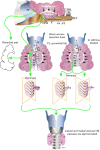Less than total thyroidectomy for goiter: when and how?
- PMID: 29322022
- PMCID: PMC5756755
- DOI: 10.21037/gs.2017.10.02
Less than total thyroidectomy for goiter: when and how?
Abstract
Benign goiter is the most common endocrine disease that requires surgery, especially in endemic areas suffering from iodine-deficiency. Recent European and American guidelines recommended total thyroidectomy for the surgical treatment of multinodular goiter. Total thyroidectomy has now become the technique of choice and is widely considered the most reliable approach in preventing recurrence. Nevertheless, total thyroidectomy carries a substantial risk in terms of hypoparathyroidism and the morbidity associated with injury to the inferior laryngeal nerve. In this context, partial/less-than-total thyroidectomy is being considered once again as a viable alternative. This review will discuss the extent of thyroid surgery for benign disease and the impact of the surgical protocol on the patient- and surgeon-specific risk factors for specific complication rates.
Keywords: Goiter; hypoparathyroidism; recurrent nerve injury; thyroidectomy.
Conflict of interest statement
Conflicts of Interest: The author has no conflicts of interest to declare
Figures



Comment in
-
Surgery for benign thyroid disease in 2018.Gland Surg. 2018 Apr;7(2):239-241. doi: 10.21037/gs.2017.12.07. Gland Surg. 2018. PMID: 29770808 Free PMC article. No abstract available.
Similar articles
-
Bilateral benign multinodular goiter: What is the adequate surgical therapy? A review of literature.Int J Surg. 2016 Apr;28 Suppl 1:S7-12. doi: 10.1016/j.ijsu.2015.12.041. Epub 2015 Dec 18. Int J Surg. 2016. PMID: 26708850 Review.
-
[Is primary total thyroidectomy justified in benign multinodular goiter? Results of a prospective quality assurance study of 45 hospitals offering different levels of care].Chirurg. 2003 May;74(5):437-43. doi: 10.1007/s00104-002-0605-3. Chirurg. 2003. PMID: 12748792 German.
-
[Complications in surgical treatment of thyroid diseases].Otolaryngol Pol. 2006;60(2):165-70. Otolaryngol Pol. 2006. PMID: 16903331 Polish.
-
Total thyroidectomy. The preferred option for multinodular goiter.Ann Surg. 1987 Dec;206(6):782-6. doi: 10.1097/00000658-198712000-00016. Ann Surg. 1987. PMID: 3689014 Free PMC article.
-
Non-recurrent inferior laryngeal nerve: case report and review of the literature.J Med Life. 2014;7 Spec No. 4(Spec Iss 4):90-4. J Med Life. 2014. PMID: 27057257 Free PMC article. Review.
Cited by
-
Surgery for benign thyroid disease in 2018.Gland Surg. 2018 Apr;7(2):239-241. doi: 10.21037/gs.2017.12.07. Gland Surg. 2018. PMID: 29770808 Free PMC article. No abstract available.
-
Total vs less than total thyroidectomy for benign multinodular non-toxic goiter: an updated systematic review and meta-analysis.Langenbecks Arch Surg. 2023 May 19;408(1):200. doi: 10.1007/s00423-023-02941-1. Langenbecks Arch Surg. 2023. PMID: 37204607
-
Patient satisfaction following thyroidectomy in surgical mission: a prospective study.Gland Surg. 2019 Aug;8(4):385-388. doi: 10.21037/gs.2019.06.06. Gland Surg. 2019. PMID: 31538063 Free PMC article.
-
Nontoxic Multinodular Goitre and Incidental Thyroid Cancer: What Is the Best Surgical Strategy?-A Retrospective Study of 2032 Patients.Int J Endocrinol. 2018 May 14;2018:4735436. doi: 10.1155/2018/4735436. eCollection 2018. Int J Endocrinol. 2018. PMID: 29887888 Free PMC article.
-
Giant multinodular goiter for 24 years; hidden in a village in Western Nepal.Clin Case Rep. 2022 Jul 25;10(7):e6041. doi: 10.1002/ccr3.6041. eCollection 2022 Jul. Clin Case Rep. 2022. PMID: 35898759 Free PMC article.
References
-
- Barbier J, Kraimps JL. Comments on the prevention of recurrence with thyroid hormone therapy. Ann Endocrinol (Paris) 1993;54:291-2. - PubMed
Publication types
LinkOut - more resources
Full Text Sources
Other Literature Sources
